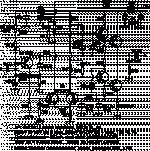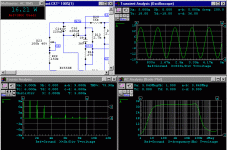Hi David,
Sliding bias Class A, neat huh?
Only even order distortion, no output device ever switches off, short protected - this is a pot of gold, and appeared in the Elektor Circuits handbook some years ago.
This circuit would sound good, but there's a fair bit of compensation, and if you increase device speed with more modern semis the compensation would need considerable revision.
Only the quasi comp and output coupling cap make it unfashionable, but it's failsafe and inexpensive to make.
Hugh
Sliding bias Class A, neat huh?
Only even order distortion, no output device ever switches off, short protected - this is a pot of gold, and appeared in the Elektor Circuits handbook some years ago.
This circuit would sound good, but there's a fair bit of compensation, and if you increase device speed with more modern semis the compensation would need considerable revision.
Only the quasi comp and output coupling cap make it unfashionable, but it's failsafe and inexpensive to make.
Hugh
Lovely schematics.
I have never listened this one...something to construct and to listen.
Maybe in November or December...when i will have time to do it.
I am scheduled with a lot of things.
Will you construct Lumanauw...i will be happy to know your evaluation.
regards,
Carlos
I have never listened this one...something to construct and to listen.
Maybe in November or December...when i will have time to do it.
I am scheduled with a lot of things.
Will you construct Lumanauw...i will be happy to know your evaluation.
regards,
Carlos
....aloha... never tried such an amp... But it is looking like I should put it to my ToDo list.
And hey guys... with modern transistors I am sure that we could strip it down to five transitors...
May be it is even possible to settle a DC-suitable biasing of the input stage+feedback. Then I could imagine to use a +/- supply and get rid of the ugly output cap.
Quite a nice inspiration for further Rookie attempts..

Lumanau,
sometimes you are digging out real nuggets.
And hey guys... with modern transistors I am sure that we could strip it down to five transitors...
May be it is even possible to settle a DC-suitable biasing of the input stage+feedback. Then I could imagine to use a +/- supply and get rid of the ugly output cap.
Quite a nice inspiration for further Rookie attempts..
Lumanau,
sometimes you are digging out real nuggets.
I love those old things, i am also trying to make it symetrical related the supply
We have ancient traditions that has formed my people...we have, Brasilians have, indians in our blood.
This way, the respect to old folks, old things done and tradition has some power here, in special inside myself.
Good to perceive that you have that respect too Choco.
I was watching this indian....i can see this face, this nose, hairs and many signs in each of us in this country.
They love old things, the experience of old folks.
This is nice.
mahalo,
Carlos
We have ancient traditions that has formed my people...we have, Brasilians have, indians in our blood.
This way, the respect to old folks, old things done and tradition has some power here, in special inside myself.
Good to perceive that you have that respect too Choco.
I was watching this indian....i can see this face, this nose, hairs and many signs in each of us in this country.
They love old things, the experience of old folks.
This is nice.
mahalo,
Carlos
Attachments
I have come across this design on two occasions from mullard
once as a germanium design and also as a silicon unit
This is pye mode operation and the amp slides from class A mode into class B as the amplifier is driven harder!
As a remember it was a nice sounding amp
Regards Trev
once as a germanium design and also as a silicon unit
This is pye mode operation and the amp slides from class A mode into class B as the amplifier is driven harder!
As a remember it was a nice sounding amp
Regards Trev
Hi, Carlos, what did you find in simulation? Does it behaves like JLH or different?I have made simulations Lumanauw....interesting.
Thanks Latala for the infoAs a remember it was a nice sounding amp
Those schematics came from the time AD149 was a special transistor.
Chromium finish...TO-3...enormous and heavy unit (weigth).
Was a 10 watts transistor, used for Voltage amplifiers and also for automobile radios push pull output...hehe.
Nice old days...people used to listen music those days...and now a days Scopes, Spectrum analisers, Simulators, Distortion Analisers seem to be the target for the industry.
regards,
Carlos
..................................................................................................
Lumanauw.
Was not good in simulations.... i am already making modifications...if something finishes with a nice result, then i will inform you some.
Well...simulator cannot tell me how it will sound...we really need to construct..will you do that?... i cannot till Nov/Dec
regards,
Carlos
Chromium finish...TO-3...enormous and heavy unit (weigth).
Was a 10 watts transistor, used for Voltage amplifiers and also for automobile radios push pull output...hehe.
Nice old days...people used to listen music those days...and now a days Scopes, Spectrum analisers, Simulators, Distortion Analisers seem to be the target for the industry.
regards,
Carlos
..................................................................................................
Lumanauw.
Was not good in simulations.... i am already making modifications...if something finishes with a nice result, then i will inform you some.
Well...simulator cannot tell me how it will sound...we really need to construct..will you do that?... i cannot till Nov/Dec
regards,
Carlos
Choco,
Even if you eliminate the output coupler, the driver earth return currents will still have to pass through the power supply caps.
I can see the appeal of no output coupler, but I have built amps with this configuration using composite caps and really, they sound just fine..... AND, if the amp fails, the speaker is safe!
Cheers,
Hugh
Even if you eliminate the output coupler, the driver earth return currents will still have to pass through the power supply caps.
I can see the appeal of no output coupler, but I have built amps with this configuration using composite caps and really, they sound just fine..... AND, if the amp fails, the speaker is safe!
Cheers,
Hugh
AKSA said:Choco,
Even if you eliminate the output coupler, the driver earth return currents will still have to pass through the power supply caps.
I can see the appeal of no output coupler, but I have built amps with this configuration using composite caps and really, they sound just fine..... AND, if the amp fails, the speaker is safe!
Cheers,
Hugh
Hi Hugh,
of course always the signal current must pass somehow through the supply caps. But from my understanding their influence is much less, because their nonlinearities will not fully be reflected in the output signal. Their influence should be greatly reduced by the closed loop PSRR of the amp, or not ?
Regarding e-caps itself... I am also not fanatic in this regard. During my Rookie games I also played around with cheap noname e-caps in the line signal area. Some 6.3V/1500uF types and I gave them a 1.5V DC voltage bias. In the beginning I could not measure and not hear any difference. Later I noticed that they caused slightly unstable distorsion results, but even after these measurements my ears did not notice a difference between the signal path with or without the caps.
But I did not feel really comfortable and decided to go for a design that does not need e-caps in the signal path. ...yes, it was more about the appeal of 'no e-cap'..
It might also depend on the ratio of Zc vs Zload.
If Zc is always very low vs Zload, then nonlinearities of Zc are probably quite uncritical. While in filter applications where Zc is similar like Zload or even dominant then the cap might be much more critical.
What are your experiences in this regard?
And speaker protection... come on.. who cares about real life advantages ?!!
Read you soon
Markus
This is one of many similar 1960s amplifier circuits published by P Tharma of Mullard Laboratories in his book -
Transistor Audio Amplifiers.
I have a copy in the roofspace (somewhere) but have not seen it for 30 years.
Initially these were all PNP except for the input transistor being a newly developed germanium NPN. BC107>9 types later became the input device. The polarities reversed when silicon power became available, and I think a germanium OC44 became the input device before PNP silicon prices fell.
I checked at Amazon, and a few copies of the book can still be found.
They were better than many tube amplifiers of their day, but would need components to be re-chosen to match today's standards.
Cheers ......... Graham.
Transistor Audio Amplifiers.
I have a copy in the roofspace (somewhere) but have not seen it for 30 years.
Initially these were all PNP except for the input transistor being a newly developed germanium NPN. BC107>9 types later became the input device. The polarities reversed when silicon power became available, and I think a germanium OC44 became the input device before PNP silicon prices fell.
I checked at Amazon, and a few copies of the book can still be found.
They were better than many tube amplifiers of their day, but would need components to be re-chosen to match today's standards.
Cheers ......... Graham.
This is an odd circuit, it is interesting that what looks like the VAS bootstrap capacitor is not that at all, it is in fact negative feedback. I believe that this is required to set the gain of the
lower half of the output stage, or it could be an error. Were the schematics redrawn?
The first diff transistor, essentially the VAS, is not bootstrapped, instead it is fed from a higher voltage supply and power out is wasted in the 4R7 in the supply line.
I'd try bootstrapping the VAS and removing the 4R7 to the output stage.
This is an odd circuit and I believe it could use some refinement.
It is interesting from a food for thought perspective.
Pete B.
lower half of the output stage, or it could be an error. Were the schematics redrawn?
The first diff transistor, essentially the VAS, is not bootstrapped, instead it is fed from a higher voltage supply and power out is wasted in the 4R7 in the supply line.
I'd try bootstrapping the VAS and removing the 4R7 to the output stage.
This is an odd circuit and I believe it could use some refinement.
It is interesting from a food for thought perspective.
Pete B.
- Status
- This old topic is closed. If you want to reopen this topic, contact a moderator using the "Report Post" button.
- Home
- Amplifiers
- Solid State
- Mullard SS power amplifier


